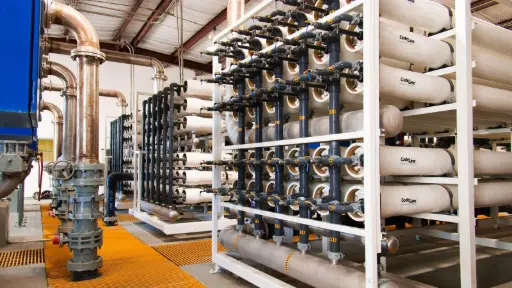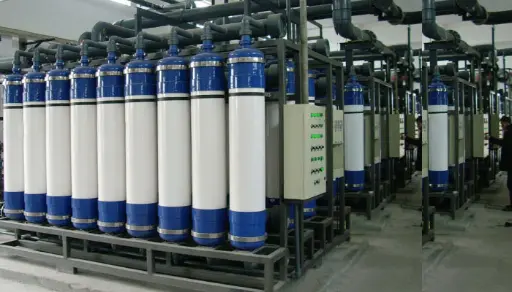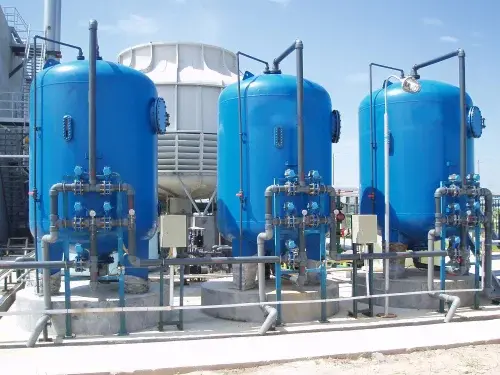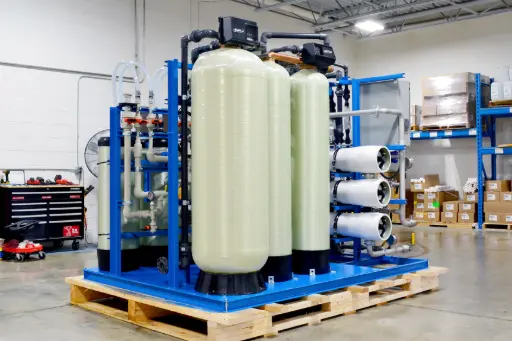Autoclave Feedwater Treatment
The medical industry depends on steam sterilization to maintain the sterility of surgical instruments, laboratory glassware and patient-care materials. Autoclaves generate saturated steam by boiling water under pressure inside a chamber, and the quality of the feedwater entering that chamber directly affects both sterilization performance and equipment longevity. When engineers speak of autoclave feedwater treatment, they refer to the process of purifying and conditioning the water used to generate steam so that it contains minimal minerals, organics, microorganisms and dissolved gases while still maintaining enough conductivity for sensors to detect level. In hospitals and biotechnology laboratories, untreated mains water may contain hardness, silica and chlorides that deposit scale or corrode wetted surfaces. Scaling reduces heat transfer and can cause catastrophic failure of electric heating elements, while chloride-induced corrosion can pit stainless steel and impair gaskets. Feedwater treatment is therefore integral to protecting capital assets and ensuring the reliability of steam sterility cycles.
Medical sterilization cycles are unforgiving: temperature and pressure must remain within narrow tolerances, and any interruption of steam supply can cause delays or incomplete sterilization. Treated feedwater supports these demands by producing high‑quality steam free of carryover droplets and particulates. Without softening and deionization, calcium and magnesium salts precipitate on chamber walls, leading to frequent downtime for descaling. Silica residues can form glassy deposits that are difficult to remove and can interfere with valves. Conversely, water that is too pure (e.g., deionized to resistivities above 1 MΩ·cm) lacks electrolytes and will leach metals from the autoclave’s piping while also confusing conductivity‑based level probes. The business value of proper feedwater treatment therefore lies in preventing repairs, extending service life, reducing cycle times and safeguarding patient safety. Many facilities specify feedwater resistivity between 0.02 and 0.05 MΩ·cm, hardness below 0.5 mmol/L and silica below 1 mg/L to balance corrosion resistance with sensor performance. Water treatment systems are installed upstream of the autoclave to achieve these targets, and operators routinely monitor quality indicators to ensure consistent operation.
Key Systems and Technologies Used in Autoclave Feedwater Treatment

Reverse Osmosis (RO)
Semi‑permeable membranes operate at 8–20 bar to reject up to 98 % of dissolved salts, hardness ions, silica and organics, producing permeate with conductivity between 10 and 50 µS/cm suitable for most hospital sterilizer boilers. RO units often include pre‑filtration and carbon adsorption to protect the membrane and are sized for the autoclave’s daily steam demand.

Ultrafiltration (UF)
Hollow‑fiber membranes with pore sizes around 0.1 µm physically remove bacteria, endotoxins and particulates that could contaminate autoclave loads or foul downstream treatment equipment. Ultrafiltration is often installed after RO and before storage tanks to maintain microbial control.

Water Softener
Sodium‑based cation exchangers replace calcium and magnesium with sodium, reducing hardness to below 0.1 mmol/L. Softeners operate at ambient pressure and require periodic regeneration with brine. They are commonly used ahead of RO systems or alone when only hardness reduction is needed for carbon‑steel steam generators.

Deionization
Mixed‑bed ion exchange cartridges remove both cations and anions to achieve resistivity above 0.1 MΩ·cm. This technology is reserved for stainless‑steel autoclaves and applications requiring very low conductivity steam, such as pharmaceutical sterilization of culture media. It is often combined with ultraviolet disinfection to prevent microbial growth in the storage tank.
Key Water‑Quality Parameters Monitored
Water used in medical sterilizers must meet defined quality targets to prevent scaling, corrosion, microbial contamination and sensor failure. Plant managers monitor several parameters in real time or through periodic sampling. Conductivity or its reciprocal, resistivity, provides a quick estimate of total ion content. Feedwater resistivity between 20 kΩ·cm and 200 kΩ·cm balances the need to minimise scale with the requirement for conductivity‑based level probes to function correctly. If resistivity drops below the lower limit, salts may deposit on heating elements and valves; if it rises too high, the water can become aggressive and corrode copper or carbon‑steel components. pH is another critical metric because steam generation concentrates alkalinity. Neutral to mildly alkaline feedwater (pH 6.5–8.0) minimises corrosion while avoiding the precipitation of hardness ions. Sudden pH swings often signal membrane failure, resin exhaustion or contamination and should trigger corrective action.
Silica and hardness are closely watched because they directly influence scale formation. Silica tends to remain dissolved until water boils; it then polymerises and deposits a glassy layer that is difficult to remove. Maintaining silica below 1 mg/L prevents this issue, and high‑purity applications may target 0.02 mg/L. Hardness, expressed as calcium carbonate equivalent, must be kept below 10–50 mg/L depending on autoclave design. Even small amounts of calcium or magnesium can form dense carbonate scale at temperatures above 100 °C. Operators employ online hardness analyzers or titration kits to verify that ion‑exchange softeners are functioning correctly. Chloride and free chlorine are controlled because they attack stainless‑steel passivation layers; typical feedwater limits are below 3 mg/L for chloride and less than 0.1 mg/L for free chlorine. Total dissolved solids (TDS) provide a broad indication of mineral content and should remain between 50 and 150 mg/L for most carbon‑steel steam generators. Microbial load, measured as colony‑forming units (CFU) per millilitre, is relevant when feedwater is stored or when the steam may contact sterile loads. Ultrafiltration and ultraviolet units help maintain CFU counts below 10 CFU/mL, and regular sanitisation prevents biofilm formation.
The temperature of feedwater is also monitored, as cold water can shock ceramic and metal components. Typical supply temperatures range from 10 to 25 °C; heating coils may temper the water before it enters the boiler to avoid thermal stress. Dissolved oxygen causes pitting corrosion and is removed by degassing or vacuum pumps; levels should remain below 0.02 mg/L. Modern sterilizer systems integrate sensors with programmable logic controllers (PLCs) to log trends and trigger alarms. Setpoints for blowdown and chemical dosing are adjusted based on these measurements. By observing how conductivity, hardness and silica vary over time, maintenance teams can optimise resin regeneration cycles and membrane cleaning intervals. Statistical control charts help detect early deviations and prevent unscheduled shutdowns. When all these parameters are kept within typical ranges, the resulting steam is dry, saturated and free of contaminants, assuring consistent sterilisation efficacy.
| Parameter | Typical Range | Control Method |
| Conductivity/Resistivity | 15–50 µS/cm (20–200 kΩ·cm) | Continuous monitoring with conductivity probes; adjust RO recovery and regenerate ion‑exchange resins. |
| Hardness | <0.1 mmol/L (10–50 mg/L CaCO₃) | Cation exchange softener regeneration; monitor with titration kits. |
| Silica | 0.1–1 mg/L (≤0.02 mg/L for high purity) | Silica‑monitoring kits; membrane and mixed‑bed polishing. |
| pH | 6.5–8.0 | pH meters and buffer dosing to adjust alkalinity. |
| Chloride | <3 mg/L | Activated carbon adsorption or blended makeup water. |
| Free Chlorine | <0.1 mg/L | Carbon filtration and chemical dosing to neutralise oxidants. |
| Total Dissolved Solids | 50–150 mg/L | RO and softening; periodic blowdown to limit concentration. |
| Microbial Load | <10 CFU/mL | Ultrafiltration, UV disinfection and regular sanitisation. |

Design & Implementation Considerations
Designing a feedwater treatment system for medical autoclaves begins with a thorough assessment of the incoming water quality and the sterilizer’s steam demand. Engineers analyse municipal supply reports and site‑specific samples for hardness, silica, chlorides, organics and microbial counts. They then select unit operations that address the dominant contaminants while complying with EN 285 and ANSI/AAMI ST79, which define steam quality requirements for healthcare sterilizers. For a hospital with multiple sterilizers, a central treatment skid supplying softened and RO‑treated water can reduce capital cost per unit, but distribution lines must be designed to prevent stagnation. The flow rate should cover peak simultaneous steam demand plus a safety margin. For example, if three autoclaves each consume 40 L per cycle and may run back‑to‑back, the treatment skid must produce at least 120 L/h of permeate. Storage tanks with recirculation loops maintain pressure and prevent microbial growth between cycles.
Material compatibility is paramount. Carbon‑steel boilers require water with modest conductivity to allow level probes to operate; they tolerate hardness up to 80 mg/L CaCO₃ but suffer from scale if silica exceeds 2 mg/L. Stainless‑steel chambers can handle ultra‑pure water but require non‑metallic piping to prevent ion leaching. System designers therefore match treatment train and autoclave material. Pretreatment filters and chemical feeds must be accessible for maintenance. Drainage and brine handling should comply with local environmental regulations because softeners discharge sodium‑rich waste. Electrical power availability, floor space and ventilation are also considered, especially for distillation units that release latent heat. Control systems should integrate with building management systems to provide alarms and status updates. To meet ISO 15883 requirements for washer‑disinfectors, some facilities install redundant pumps and sensors to ensure continuous supply. Commissioning includes validation of flow, pressure and quality, and documentation forms part of the facility’s quality management system.
Operation & Maintenance
Once commissioned, an autoclave feedwater treatment system requires structured operation and maintenance routines to remain reliable. Operators perform daily checks of conductivity, pH and temperature, comparing readings against the display setpoints. Blowdown of boilers and softened brine must be conducted weekly or as recommended by manufacturer guidelines to remove accumulated solids and prevent foaming. Filter cartridges upstream of RO membranes are replaced every two to three months to prevent fouling and ensure stable differential pressure. Regeneration of softening resins uses saturated brine; technicians verify salt levels monthly and clean brine tanks to avoid bridging. Reverse osmosis membranes undergo chemical cleaning when permeate flow drops by more than 15 % or when salt rejection deteriorates. Deionization cartridges are monitored using resistivity meters, and mixed‑bed units are exchanged when resistivity falls below the setpoint, often after six months of use.
Maintenance extends beyond the treatment equipment. Autoclave chambers that generate steam in situ concentrate impurities during each cycle; operators drain and wipe down the reservoir weekly to prevent build‑up of dissolved solids and biological residues. Vacuum pumps and water‑ring seals that rely on feedwater require flushing and inspection to avoid microbial growth. Ultraviolet lamps degrade over time and should be changed annually to maintain disinfection efficacy. Control sensors—conductivity probes, pH electrodes and flow transmitters—require calibration at defined intervals, often every six months, following traceable standards. Plant managers maintain logs of measurements, replacements and service activities; these records support accreditation audits and help identify recurring issues. Training of staff is crucial: they need to understand how to interpret alarm codes, adjust operating parameters, and perform basic troubleshooting. When high purity is required, operators must avoid cross‑contamination from hoses, cleaning agents or ambient dust. If water quality deviates from specification, immediate corrective action prevents sterilizer downtime or compromised cycles.
As an example of daily operational planning, consider an autoclave that consumes 90 L of feedwater per cycle and runs 10 cycles per day. If the reverse osmosis system operates at 75 % recovery, the required feed flow can be estimated using the formula for recovery ratio. The calculation shows that approximately 1200 L/day of raw water must be supplied to produce sufficient permeate for the autoclave. This simple mass balance informs the sizing of pumps, storage tanks and softening capacity and underscores the importance of matching treatment equipment to process demand.
Challenges & Solutions
Operating feedwater treatment systems in healthcare environments presents several challenges that require proactive management. Problem: Scaling remains the most common issue in carbon‑steel boilers fed with moderately hard water. Even with softeners, trace hardness and silica precipitate when the water is repeatedly boiled, forming insulating layers on heating elements. Solution: Implement a combination of softening and reverse osmosis, accompanied by scheduled blowdown and periodic chemical descaling using mild citric acid. Monitoring hardness effluent and adjusting regeneration cycles prevents scale formation before it becomes problematic.
Another challenge arises from corrosion due to dissolved oxygen and chlorides. Problem: Low levels of dissolved oxygen can pit stainless steel and erode copper piping, while chlorides accelerate stress‑corrosion cracking. Solution: Employ deaeration techniques such as vacuum degassing or membrane contactors to reduce oxygen to below 0.02 mg/L, and incorporate activated carbon or mixed‑bed polishing to lower chloride content. For facilities near the coast or with saline groundwater, blending treated water with desalinated supply reduces chloride concentration further.
Microbial contamination can thrive in storage tanks and feed lines if temperature and disinfectant levels are uncontrolled. Problem: Biofilms forming inside tanks can release endotoxins into the feedwater and compromise sterilization loads. Solution: Specify smooth, sanitary tank surfaces, maintain recirculation loops with turbulence to discourage biofilm adhesion, and integrate ultraviolet disinfection or ozone dosing. Regular sanitisation of tanks and piping with hot water or chemical agents keeps microbial counts below thresholds.
In some cases, water may be too pure for conductivity probes, leading to false low‑water alarms. Problem: Deionized feedwater above 1 MΩ·cm can cause level sensors to fail, shutting down the autoclave during a cycle. Solution: Install conductivity‑based make‑up blending systems that mix a small stream of softened water into the ultra‑pure supply to maintain resistivity within the acceptable window. Alternatively, upgrade to capacitive or optical level sensors that do not rely on water conductivity.
Finally, feedwater treatment systems themselves can be sources of downtime due to membrane fouling, resin exhaustion or mechanical failures. Problem: When the treatment train is offline, autoclaves may be forced to run on untreated water, leading to accelerated wear. Solution: Implement redundancy by installing duplex filters and parallel RO modules; maintain an inventory of consumables; and plan preventive maintenance during low‑use periods. Remote monitoring and diagnostic software can alert maintenance teams to declining performance before it affects production, enabling timely intervention.
Advantages & Disadvantages
Implementing a comprehensive feedwater treatment system brings substantial benefits to healthcare facilities. Extended equipment life is perhaps the most significant advantage: removing hardness, silica and chlorides prevents scale and corrosion, which can otherwise shorten boiler life or cause sudden failure. Treated water yields consistent steam quality, which directly impacts sterilization efficacy and patient safety. Energy efficiency also improves because clean heat transfer surfaces require less energy to produce the same amount of steam. Operational reliability is enhanced, reducing unexpected downtime and allowing surgical suites and laboratories to adhere to tight schedules. Adherence to standards and guidelines such as EN 285 and ANSI/AAMI ST79 is easier when water quality is controlled, aiding compliance with regulatory inspections and audits. Moreover, the ability to tailor water purity for specific applications—ranging from general instrument sterilization to pharmaceutical-grade loads—provides flexibility within the same facility.
However, feedwater treatment introduces additional capital and operating costs. Equipment such as softeners, RO units and distillation systems require investment, and space must be allocated for installation and maintenance. Consumables like membranes, ion‑exchange resins and activated carbon have finite lifespans and must be replaced regularly. Operators must be trained to monitor quality and perform maintenance, increasing labour demands. Waste streams from softener regeneration and RO concentrate must be managed responsibly to comply with environmental regulations. Highly purified water is more aggressive and, if incorrectly used with carbon‑steel boilers, can cause corrosion and sensor malfunctions. Complex treatment trains also introduce more points of potential failure, so redundancy and monitoring become critical. Balancing these advantages and disadvantages requires a holistic view of facility needs, budget constraints and risk appetite.
| Aspect | Pros | Cons |
| System Longevity | Protects boilers from scale and corrosion, reducing repairs and extending lifespan | Initial capital expenditure and periodic component replacement. |
| Steam Quality | Produces clean, dry steam that improves sterilization and reduces staining | Over‑purification can lead to corrosive water and sensor issues. |
| Energy Efficiency | Improves heat transfer and reduces fuel or electricity consumption | Treatment systems consume electricity and may require pump energy. |
| Compliance | Eases adherence to industry standards and regulatory audits | Generates additional documentation and monitoring requirements. |
| Operational Reliability | Reduces unplanned downtime and allows predictable scheduling | Requires trained personnel and introduces complexity to operations. |
Frequently Asked Questions
Question: Why can’t I use deionized water directly for all autoclaves?
Answer: Although deionized water is free of dissolved ions, it has very high resistivity and will aggressively dissolve metals. Carbon‑steel or copper components in many hospital sterilizers rely on a thin oxide layer for corrosion resistance; ultra‑pure water will strip this layer and cause pitting. Moreover, level probes in carbon‑steel boilers depend on electrical conductivity to detect water presence. When water resistivity exceeds about 200 kΩ·cm, these probes may fail, leading to false low‑water alarms or heater burnout. For stainless‑steel autoclaves, deionized water can be used, but the piping must also be stainless or polymer, and non‑conductive level detection is required.
Question: How often should I regenerate a water softener used for autoclaves?
Answer: Regeneration frequency depends on hardness loading, resin capacity and volume of water treated. Most healthcare facilities with hardness below 100 mg/L CaCO₃ regenerate their cation exchange softeners once every two to three days or after treating a fixed volume calculated from resin capacity. Monitoring hardness in the softener effluent is the best way to determine when regeneration is needed. When hardness creeps above the setpoint—typically 10 mg/L for autoclave feedwater—an immediate regeneration is initiated. Regular inspections of salt levels in the brine tank ensure that regeneration cycles are effective.
Question: Do I need ultrafiltration if my reverse osmosis system already removes bacteria?
Answer: Reverse osmosis membranes reject most microorganisms, but they are not considered absolute barriers. Post‑RO storage tanks and distribution lines can become colonised by bacteria, particularly if water remains stagnant or if tank surfaces are rough. Ultrafiltration, with pore sizes around 0.1 µm, provides an additional physical barrier that retains bacteria, endotoxins and suspended solids downstream of RO. Coupled with ultraviolet disinfection or periodic chemical sanitisation, ultrafiltration helps maintain a low microbial count (<10 CFU/mL) in stored feedwater and ensures that steam generated from that water does not introduce biological contaminants into the autoclave.
Question: What is the recommended pH range for autoclave feedwater and why?
Answer: A pH range between 6.5 and 8.0 is generally recommended for feedwater. Neutral to slightly alkaline conditions minimise corrosion of steel and copper while preventing the precipitation of hardness salts. Acidic water (pH <6.5) can leach metals and damage gaskets, whereas highly alkaline water (pH >9) increases the risk of calcium carbonate scaling. Maintaining pH within the specified range also ensures that any chemical additives used for corrosion control function optimally. Continuous pH monitoring and occasional manual testing allow operators to adjust alkalinity via acid or caustic dosing as needed.
Question: How do I size a reverse osmosis unit for my sterilizer demand?
Answer: Sizing starts with calculating the daily or hourly water consumption of the sterilizers. Multiply the volume of water converted to steam per cycle by the number of cycles and divide by the desired system recovery. For example, if a sterilizer uses 80 L per cycle and runs 12 cycles per day, it requires 960 L of permeate. At 75 % recovery, the RO unit must handle 1280 L of feed. Add a buffer for backflushing and membrane cleaning, and ensure that pumps and storage tanks can accommodate peak flow rates. Manufacturers provide sizing tables and software to assist, but understanding your process demand is crucial.
Question: Can I discharge softener brine and RO concentrate to the hospital sewer?
Answer: Disposal regulations vary by municipality, but brine from softener regeneration and concentrate from reverse osmosis contain elevated levels of sodium and dissolved solids. Many jurisdictions allow discharge to the sanitary sewer if concentrations fall below specified thresholds. It is important to consult local environmental guidelines and obtain approvals. In some cases, facilities may need to collect concentrate for off‑site disposal or reuse it in non‑critical applications like cooling towers. Implementing water recovery strategies can reduce the volume of concentrate and lower overall water consumption.
Question: What instruments should I install to monitor water quality for my autoclave?
Answer: At minimum, you should install inline conductivity or resistivity sensors, pH meters and flow meters to track key parameters continuously. Hardness can be monitored with automatic titration analyzers or manually with test kits. Silica analysers provide early warning of membrane breakthrough, and free chlorine sensors ensure that activated carbon filters are protecting downstream systems. UV intensity sensors help verify the performance of disinfection lamps. All instruments should be connected to a data logger or building management system to provide trend analysis and alarms. Regular calibration of these sensors ensures that readings remain accurate and reliable over time.
Question: How does boiler blowdown relate to feedwater quality?
Answer: Blowdown is the process of draining a portion of the boiler water and replacing it with fresh feedwater to control the concentration of dissolved solids. As steam is generated, only pure water leaves the boiler, leaving minerals behind. Without blowdown, TDS and silica levels in the boiler rise, increasing the risk of scale and carryover. The blowdown rate is calculated based on feedwater quality and desired boiler water limits. For example, if the feedwater TDS is 100 mg/L and the boiler water limit is 3500 mg/L, the blowdown fraction might be set at around 3 %. Automatic blowdown valves can be programmed to maintain this fraction, and adjusting blowdown frequency helps compensate for fluctuations in feedwater quality.